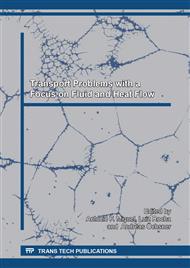p.24
p.31
p.39
p.48
p.58
p.64
p.73
p.83
p.108
LAD2D: A Computer Code for Detonation Fluid Dynamics Problems with Large Distortion and Internal Slip
Abstract:
This paper describes the LAD2D computer code, which numerically solves the equations of transient, multilaterals, compressible fluid dynamics. Of particular interest is the general capability to handle material interfaces, including slip, cavitations, or void closure. Also included is the capability to treat material strength and plasticity, as well as high explosive (HE). LAD2D uses a Lagrangian finite volume numerical technique. The method manages the sliding meshes and the internal meshes unifying as arbitrary polygonal meshes, and present a new changing connectivity of mesh technology based on the moving position of grid points with their topological relations. Of particular interest is the changing connectivity of mesh to handle the large deformation mesh and to close the gap during numerical simulation. The verification and validation (V&V) of LAD2D software was implemented based on the foundation of scientific software’s V&V method. Several applications of the changing connectivity of mesh are presented with comparison of calculations with experimental results to demonstrate the capability of the new method. The changing connectivity of mesh may be used on arbitrary geometries, using structured or unstructured meshes, and it leads to strong numerical simulation capability for multilaterals problems.
Info:
Periodical:
Pages:
58-63
Citation:
Online since:
November 2017
Authors:
Price:
Сopyright:
© 2017 Trans Tech Publications Ltd. All Rights Reserved
Share:
Citation:


